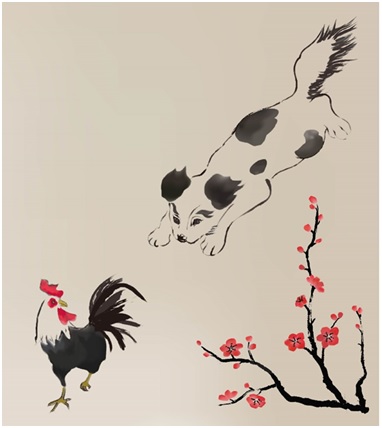Research News
Dr. Minmin Luo’s lab revealed the hypothalamic circuits for predation and evasion
On February1st, 2018, Dr. Minmin Luo’s lab published a paper titled “Hypothalamic circuits for predation and evasion” in Neuron online.This study reports that the inhibitory and excitatory projections from the lateral hypothalamus (LH) to the midbrain periaqueductal gray (PAG) drive, respectively, predation and evasion. By remotely controlling these two subpatheways, the authors can instantly turn mice into ferocious hunters or fleeing escapee.

A cover image in Chinese ink paint style summited to Neuron depicts a dog chasing after a rooster. As both dog and rooster are the Chinese zodiac, the cover also suggests the going of the year of rooster and the coming of year of dog. Artwork by Weixin Zhong.
The interactions between predator and prey represent some of the most dramatic events in nature, and constitute a matter of life-and-death for both sides. The hypothalamus has been implicated in driving predation and evasion. Classical electrical stimulations revealed various hot spots for “quiet biting attack” and evasion behavior. However, due to the technical limitations, the exact hypothalamic neural circuits underlying these behaviors remain poorly defined. In this study, Minmin Luo’s lab tested whether there isa “predatory attack center” in the brain that coordinates how these multiple brain areas drive predation behavior. Through a systematic screening, they focused their attention onto the lateral hypothalamus.The LH has traditionally been considered to be important for promoting reward seeking, feeding, and arousal.The LH contains many genetically distinct cell populations, and recent advances in neural circuit probing technologies now enable examination of the discrete functions of particular hypothalamic circuits.Using both projection-specific and cell-type-specific optogenetic manipulation, as well as fiber photometry recording, they demonstrate that inhibitory (GABA) and excitatory (glutamate) projections from the mouse LHto the periaqueductal gray PAG in the midbrain drive, respectively, predation and evasion.
A graph abstract shows the inhibitory (GABA) and excitatory (glutamate) projections from the mouse LH to the periaqueductal gray PAG in the midbrain drive, respectively, predation and evasion.
Minmin Luo’s group adopted a dual-virus strategy to expresslight sensitive proteins in a cell-type- and projection-specific manner. Theyfirstly injected a retrograde-transport-orientated adeno-associated viral (AAV) vector carrying Cre-recombinase-dependent Flp (AAV-retro-DIO-Flp) into the PAG,and then injected a Flp-dependent vector AAV-fDIO-ChR2 into the LH of transgenic Vgat-Cre mice (a transgenic mouse line with Cre expression specific in inhibitory/GABA neurons) to selectively express the light sensitive cation channel ChR2 in LH GABA neurons projecting to the PAG. Optogenetically stimulating these PAG-projecting LH GABA neurons drove strong predatory attack. In a cricket-hunting task, without optogenetic stimulation, the nonhungry cricket-naïve mice rarely initiated predatory attack against crickets. Immediately following optogenetic stimulation, mice initiated predatory attack, sniffing vigorously around the test chamber, rushing toward a cricket and subduing it with their forepaws, and eventually delivering repeated killing bites with a 91% probability.Moreover, optogenetic stimulation caused the mice to pursue, attack, and voraciously bite the artificial prey disk.In an artificial attacker evasion task, mice would turn and run away to escape from artificial attacker strikes in typical evasion behavior. However, immediately following stimulation of LH GABA neurons, a mouse would stop running away from disk strikes, instead turning its body around and starting to attack and bite the disk, demonstrating that stimulating LH GABA neurons can produce a sufficiently strong attack drive to switch behavior from evasion to predation.Inhibiting these cells reversibly blocked predation. These findings demonstrate the PAG-projecting LH GABA neurons are necessary and sufficient to drive predatory attack.
In contrast, LH glutamate neurons were activated during evasion. Stimulating PAG-projecting LH glutamate neurons drove evasion. Activating these neurons caused hungry mice to cease the food retrieval and consumption behaviors immediately, and to run awayfrom the food. However, inhibiting them did not block the evasion movement, but impeded predictive evasion from danger.Therefore, the seemingly opposite behaviors of predation and evasion are tightly regulated by two dissociable modular command systems within a single neural projection from the LH to the PAG.
The study provide a fundamental understanding of the evolutionary conserved behaviors—predation and evasion. Considering that activation of the LH is known to be involved in maladaptive behaviors such as compulsive food seeking induced by the LH activation and anorexia caused by lesion of the LH, manipulating the neuronal activity in the inhibitory LH-PAG neural circuit may also facilitate therapeutic interventions for eating disorders. The role of LH glutamate neurons in predictive evasion represents an important new insight into the neural basis of maladaptive danger prediction. Further identification of molecular and cellular features within the glutamatergic circuit from the LH to the PAG may provide clues leading to interventions for behavioral disorders related to the processing of danger signals.
NIBS postdoc Dr. Yi Li and PTN Tsinghua student Jiawei Zeng are co-fist authors of this paper. Dr. Minmin Luo is the corresponding author. Other contributing authors including Dr. Juen Zhang, ChenyuYue, WeixinZhong, Zhixing Liu and Qiru Feng are all from NIBS. This study was supported by MOST 973 grants, NNSFC, and Beijing Municipal Government. All work was completed in NIBS.



